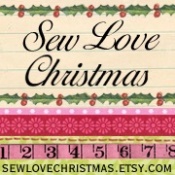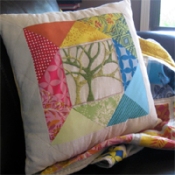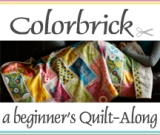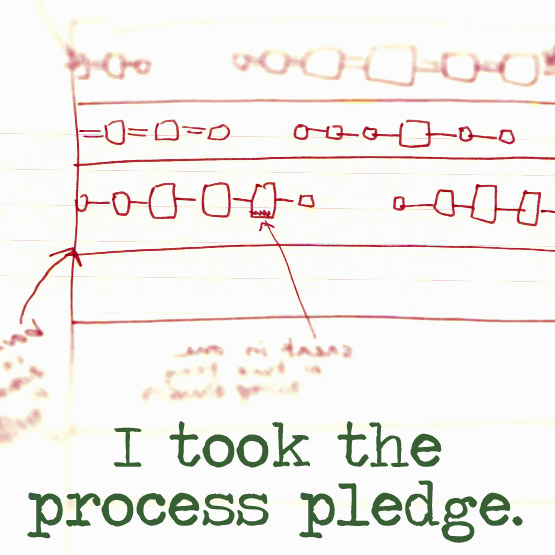This post is part of a series {Colorbrick} a Beginner’s Quilt-Along. You can join in anytime, even if you’re not a beginner! Please see this page for links to all posts, and join us on Flickr to share your questions and work-in-progress!
I cannot tell you how excited I am that so many of you want to participate! I am completely honored. Well, I can tell you’re ready to get started! Let’s talk about the part that makes us all giddy…
Choosing Your Prints
You’ll need at least 10 fat quarters to complete the Colorbrick Quilt. But, guess what, you can use more if you like! I’m using these 13 fat quarters from the Modern Meadow collection by Joel Dewberry (found here and here).

So, how did I choose? I am making this quilt for my sister, who wants a quilt with navy, wine and burnt orange. At first I tried to piece these colors together from different lines. But, since I shop on the internet for fabric, that is pretty darn hard. Modern Meadow had some great prints in my sister’s preferred colors. And, the beauty of using a designer’s collection is that you can trust it to match (one wine and another, for example) and to coordinate (this navy harmonizes well with the orange). Off to a good start! Next, I added in some brown prints for a neutral. So far this quilt was looking pretty dark (navy, wine, burnt orange, bark brown). To give it more variety in value I added the lightest brown herringbone and some aqua blue prints (a color favored by her husband).
At this point, I was pretty happy with my selections. I had 11 fat quarters. After settling on making the Colorbrick style, I tried to pinpoint what makes me love this quilt so much.

And I decided, that what I love most is the way the colors dance as the eye is drawn from brick to brick. How does that happen? It’s because of the wide variety of colors and value in the quilt (all thanks to Anna Maria Horner, of course!). So… I opted to add 2 Modern Meadow yellow prints to keep the navy, wine, orange, aqua and brown company. A fuller spectrum of the rainbow = happy color dance! Done.
So, as you go about choosing your fabrics, here are my main thoughts:
Using a Designer’s Collection is a smart and convenient choice, especially if you’re shopping online. The designer has done most of the work for you!
If Piecing Together from Different Collections shop in person or search Flickr for more pictures of the fabrics you are considering for more accurate coordinating. Some ideas for color inspiration – a favorite color in all it’s many hues, a pair of colors (blue/green, pink/orange, etc.) or gray with any color (especially with mustard, purple or berry).
For a Color Dance look to represent all but 1-2 main colors (my Modern Meadow selections lack green and purple) or the complete rainbow. Go light on neutral prints in grays or browns.
Consider Scale. Each printed rectangle will finish at 5.25 x 9.5″. This is fairly large block, and serves large prints like the Modern Meadow tree well. Medium scale prints are very effective. Small prints like a small dot, tiny floral or thin stripe will give the quilt a more “simple” look. I prefer a mix of large and medium scale prints.
Consider Variety. Quilting fabric collections usually include a variation of dot, stripe and floral. That’s because a variety of print types adds to the fun. If you’re a classic type of gal, you may like an interpretation like Nicey Jane. Meadowsweet is more vintage. Good Folks (which I used on the original Colorbrick quilt) has a folksy flair and Urban Circus is completely playful. But, if you look closely, they generally include a version of dot, stripe and floral.
Use Value. Aim for a mix of light, mid and dark value prints. Don’t know about value? See this post. A quilt made up in one value can be a little flat and boring. Don’t worry overmuch here, it’s not rocket science. If you like it – great!
Choosing Your Solid
The Colobrick quilt is sashed and backed in a solid neutral. Since the sashing is the grout, I suggest a neutral brown, white or pale gray. The quilt has a solid backing in the same neutral as the sashing, which keeps things simple (beginner quilt, remember?) and showcases the stair-step quilting design.

I ♥ Linen! Natural linen is what I used on the original Colorbrick and it’s what I’ll be using this time too. Fabric-Store.com is a great source for linen that’s nice and wide, so that you don’t have to piece the back at all. I’ll be using the IL019 in Natural, which is just $5.97 a yard! If you purchase your linen from Fabric-Store.com, choose from any of the colors in the IL019 line, since it’s a medium weight linen and all colors are 59″ wide. You’ll need 3 3/4 yards of linen, but you’ll have to buy 4 yards, since they only cut full yards.
Most fabrics are not manufactured at 59″ wide. The standard width is 44 or 45″ wide. Kona Cotton is 44/45″ wide and Essex Linen/Cotton Blend is 43″ wide. If you buy your neutral in any of these widths you’ll need to buy 5 yards total. Sew Fresh Fabrics, who is a great source of both Kona and Essex, is offering my readers free shipping on an order of $30 or more. Just note that you are participating in the Colorbrick Quilt-Along and they will refund your shipping fees within 48 hours! A nice white is Kona Snow. Kona Ash is a well-loved light gray. And, at this listing you can compare Kona Stone and Natural. Essex Cotton/Linen in Natural is lighter and grayer than most natural linen. But, it is the neutral I used here. Essex Putty is a darker neutral shade. And, Essex comes in white too.
Linen, Kona Cotton or Essex Linen/Cotton? I’ll be honest – linen is not as easy to work with as cotton. It tends to be a little shifty when cutting and sewing. For me, it’s worth it because I love the look and texture. It’s so natural, so earthy. Essex is a linen/cotton blend precisely designed to marry the beauty of linen with the ease of sewing on cotton. It is as easy as Kona to work with, but not as pretty as linen in my opinion. Honestly, not as pretty by far. Some suggest using starch to prevent linen from shifting while cutting/sewing.
If You Buy Linen from Fabric-Store.com remember that you need only 4 yards. Your fabric is so wide that you won’t have to stitch together a backing at all. One large piece will do the trick!
If You Buy Essex Linen/Cotton or Kona remember that you need 5 yards of fabric. Also, your quilt is wider than this fabric, so you will have the piece together a quilt backing that is big enough. This doesn’t have to be difficult, but it is one more step. To avoid a random-seam-line appearance, I’ll recommend that you piece together 1 row of 5 bricks to span the backing with solid on each side.
Phew!!! A complete materials list will be posted tomorrow!
Read Full Post »













